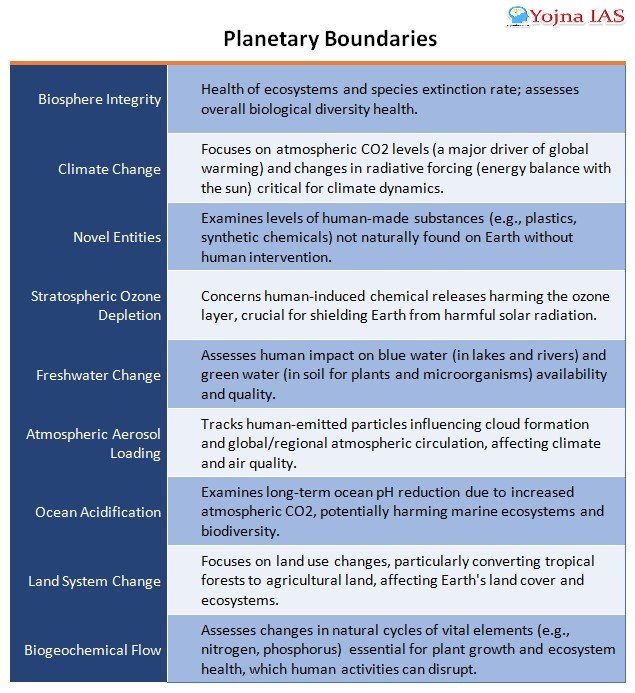25 Sep 2023 Planetary Boundaries
This article covers “Daily Current Affairs” and the topic details “Planetary Boundaries”. This topic has relevance in the “Environment and Ecology” section of the UPSC CSE exam.
For Prelims:
What are Planetary Boundaries?
Current Status?
For Mains:
GS3: Environment and Ecology
Why in the news?
A recent study has revealed that humanity has exceeded six of the nine critical planetary boundaries essential for maintaining the stability and resilience of Earth’s ecosystems.
Planetary Boundaries
- Planetary boundaries serve as a critical framework that sets limits on how much human activity can impact Earth’s natural systems. In simpler terms, it provides guidelines on how we can use Earth’s resources without drastically altering the environmental conditions that support our way of life.
- This framework was developed in 2009 and defines nine specific planetary boundaries. Scientists believe these boundaries encompass all the crucial processes necessary to maintain Earth’s stability.
- For each boundary, specific control variables are chosen to represent the most significant ways human activities impact that particular aspect of the planet.
Nine Planetary Boundaries

About the Study
- This study represents an update to the planetary boundaries framework, initially introduced in 2009 to establish safe boundaries within which humanity can operate environmentally. To achieve this, the researchers embarked on a comprehensive process:
- They began by identifying the essential processes within Earth’s ecosystem that have been pivotal in maintaining favourable conditions for human existence over the past 12,000 years.
- Subsequently, they conducted an assessment of the extent to which human activities are altering these crucial processes.
- They aimed to pinpoint the threshold at which human actions pose a significant risk of initiating potentially profound and irreversible changes in Earth’s overall conditions.
- It’s important to note that breaching individual boundaries does not immediately spell disaster.
- However, such breaches elevate the risk of initiating processes that could dramatically and irreversibly alter the overall environmental conditions on Earth to a point where our current civilisation can no longer be sustained.
Findings of the Study
- Planetary Boundary Breaches
-
- Human activities have breached six of the nine planetary boundaries: climate change, biosphere integrity, freshwater change, land system change, biogeochemical flows, and novel entities.
-
- Atmospheric aerosol loading and ozone depletion remain within acceptable limits, but ocean acidification is nearing a breach.
- Biogeochemical Flow Overflow
-
- The overflow of nitrogen and phosphorus, related to the biogeochemical flow boundary, is particularly concerning.
- While these elements are essential for life, their widespread use as crop fertilisers has led to issues like algal blooms and oxygen-depleted ocean dead zones, harming ecosystems.
- Rising Levels of Novel Entities
-
- Human activities have led to a notable increase in novel entities in the environment.
- Unprecedented amounts of synthetic chemicals, such as pesticides and plastics, have been released without sufficient safety testing, destabilising Earth’s systems.
- Land System Change
-
- Deforestation in the Amazon tropical forest has increased to the extent that it has breached the planetary boundary.
- Climate Change
-
- Both atmospheric CO2 concentration and radiative forcing are steadily rising concerning climate change.
- CO2 concentration stands at 417 ppm, well above the safe boundary limit of 350 ppm, which was breached in the 1980s during the Industrial Revolution.
Way Forward: A Ray of Hope
- Notably, there’s a positive example in the form of the stratospheric ozone depletion boundary, which is on the path to recovery. This progress resulted from international cooperation initiated by the Montreal Protocol in 1987.
- Researchers believe such coordinated efforts can serve as a model for addressing other breached boundaries and safeguarding our planet’s health.
Sources: Humans breach most of the planetary boundaries that keep Earth habitable
Download Yojna daily current affairs eng med 25th Sep 2023
Q1. With reference to Planetary boundaries, consider the following statements:
- Planetary boundaries limit human activity’s impact on Earth’s natural systems, preserving environmental conditions for our well-being.
- The planetary boundaries framework was developed in 2009, defining twelve specific boundaries encompassing critical processes for Earth’s stability.
- As per recent studies, six planetary boundaries have been breached by human activities
Which of the statements given above is/are correct?
(a) 1 and 2 only
(b) 2 and 3 only
(c)1 and 3 only
(d) None
Answer: (c)
Q2. Consider the following:
- Renewable Energy Transition
- Biogeochemical Flow
- Stratospheric Ozone Depletion
- Biosphere Integrity
- Biodiversity Connectivity
How many of the above are planetary boundaries as delineated in the 2009 framework?
(a) Only one
(b) Only two
(c) Only three
(d) Only Four
Answer: (c)
Q3. What are planetary boundaries, and why are they essential for global sustainability? Discuss the significance of international cooperation in managing planetary boundaries and propose measures for effective implementation.


No Comments